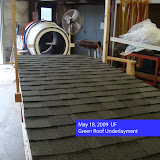Never one to be an alarmist, I will remind all we are in the generation of peak oil.
As demands on petro supplies increase and supplies decrease we need to look to alternatives.
 |
| Lightweight Rooftop Permaculture Systems |
Rooftop permaculture offers many solutions to food, cooling, habitat creation and wildlife integration, cleaning stormwater, carbon sequestration, oxygen production and more.
If people spent one hour per day working in their rooftop permaculture garden the world's population would be healthier, both physically and mentally.
Work with growing plants and food on the rooftop for six months, eating the greens and veggies you grow, watching the urban core wildlife come to the plants, experiencing intense nature first hand - do so and I promise you your blood pressure will drop ten diastolic and systolic points and you will loose twenty pounds.
Your stress levels will be drastically reduced and your love and wonder of experiencing life will be regenerated.
You will go to your rooftop garden before you leave for work and soon after you arrive home, greeting wildlife visitors, breathing fresh oxygen and admiring how your plants grow.
Once you create a rooftop garden you will build another and another.
Dates, herbs, spices, yucca, parsley, rosemary, sage, cactus, alliums, succulents, plants requiring only nature based irrigation grow successfully, spreading across the lightweight green roof mat quickly and fully.
Because your green roof system is only inches thick it can be installed practically anywhere.
Try your metal shed in the backyard or garden shed in the courtyard. Add vegetation to your main roof, small or large and even across the tops of large apartment buildings and community structures.
Because your green roof is mat based the plants will move themselves over time across the mat to the ideal exposures and micro-climates on a roof.
You will learn of fog nets, dew catchers and grey-water recycling.
Here in Jacksonville we are in a long and serious drought approximate 350mm behind in average rainfall for the year (14 inches),
We are in a seven week drought with no significant rainfall accumulation.
Yet the rooftop gardens thrive.
Understanding how to design these small, rooftop permaculture gardens has been our passion. Sharing this information is our future.
Growing greens, herbs, vegetables, flowers and plants is a key and core element of long-term sustainability as we pass peak oil.
Growing food on the rooftop saves automobile trips to the grocery store.
Green roofs cleans stormwater, sequesters carbon and the green roof plants pump oxygen into the air every minute of every day.
Green roofs attract native wildlife, anoles, frogs and the hawks, kites and owl raptors, providing wonderful integrated pest management created by nature.
Your doctor visits and health costs will decrease as your fresh air intake, exercise and new diet of homegrown vegetables and greens becomes routine.
You will feel young again as you experiment with new plants, and feel, smell and taste new sensations.
Green roof permaculture. Understanding sustainability in the post-peak oil environment.
Let us help you with your green roof permaculture and sustainability design.
Email us today with your requirements.
MetroVerde. Arid, Dry Green Roof Permaculture for Post-Peak Oil Ecology.
Happy Green Roofing.
Kevin













































